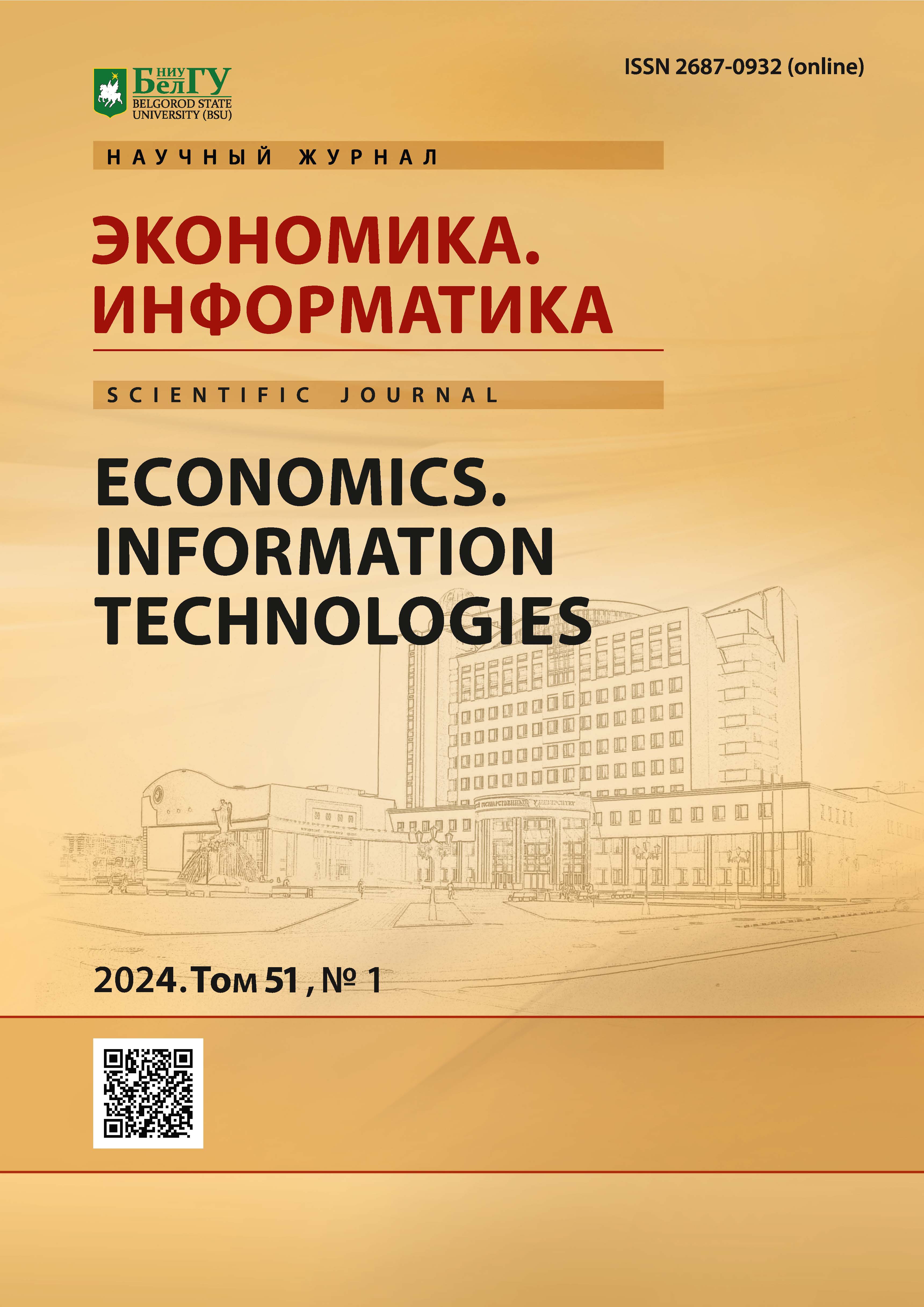Reserves for Growth of Labor Productivity of an Industrial Enterprise as a Component of Its Development Potential
DOI:
https://doi.org/10.52575/2712-746X-2024-51-1-107-120Keywords:
labor productivity management, manufacturing industry, internal production reserves, digitalizationAbstract
One of the most important problems of the modern Russian economy remains the problem of increasing labor productivity. Technological progress creates conditions to solve it and at the same time generates new restrictions and difficulties in the growth of labor productivity. For the country as a whole, its individual regions and industries, labor productivity is one of the main indicators of economic development. Thus, the topic of labor productivity growth in the economy and especially in industry has been and remains relevant, requiring further research. The work uses general scientific and special methods to substantiate the propositions put forward. The research results are presented by systematizing the tools of managerial influence on the processes that ensure the growth of labor productivity, their division into tools of direct and indirect impact, followed by the identification and detailed description of the instruments of indirect influence, which are very diverse by structure. The authors justify the need to consider labor productivity management through the implementation of management functions, additionally introducing forecasting and coordination as separate and independent functions. Hence the effect of labor productivity management in the form of finding and using internal production reserves can be distinguished and systematized. It gives the opportunity to determine the type, place in the enterprise system and direction of applied reserves. The article presents a methodological approach to calculating the components of an enterprise's potential using the coefficient method. Particular attention in the article is paid to identifying the possibilities of digitalization and innovation reserves and their assessment. Groups of indicators, their calculation and impact on changes in the innovation and digitalization potential of industry in recent years are revealed as well. The authors came to the conclusion that the reserves for growth in labor productivity of an industrial enterprise depend, among other things, on the group the enterprise belongs according to its level of digitalization.
Downloads
References
Список источников
Валовая добавленная стоимость в основных ценах в соответствии с методологией СНС 2008. Режим доступа: URL: https://www.fedstat.ru/indicator/58250. (дата обращения: 22 ноября 2023).
Гастев, А.К. 1973. Трудовые установки. М.: Экономика, 343 с. Режим доступа: URL: https://pma.knigogid.ru/books/468960-trudovye-ustanovki/toread/page-150 (дата обращения: 15 ноября 2023).
Индикаторы цифровой экономики: 2022: статистический сборник. Режим доступа: URL: https://issek.hse.ru/mirror/pubs/share/780810055.pdf. (дата обращения: 16 ноября 2023).
Количество фактически отработанного времени на всех видах работ по производству товаров и услуг (в среднем за год) с 2017 г. Режим доступа: URL: https://www.fedstat.ru/indicator/58993?ysclid=lnfyjspstt858876396. (дата обращения: 22 ноября 2023).
Лукас Р.Э. 2013. Лекции по экономическому росту. М.: Изд-во Института Гайдара, 288 с.
Мескон М.Х. 1993. Основы менеджмента. М.: Дело, 704 с.
Паспорт национального проекта (программы) «Производительность труда и поддержка занятости» (утв. президиумом Совета при Президенте РФ по стратегическому развитию и национальным проектам) (протокол от 24 декабря 2018 г. N 16). Режим доступа: URL: https://base.garant.ru/72185994/ (дата обращения: 16.11.2023).
Пруденский Г.А. 1972. Проблемы рабочего и нерабочего времени. М.: Изд-во «Наука», 335 с.
Тейлор, Ф.У. 1991. Принципы научного менеджмента. М.: Контроллинг, 104 с.
Хайем А. 17 способов повысить мотивацию персонала. Режим доступа: URL: https://www.elitarium.ru/motivacija-sotrudnikov-stimulirovanie-personala-kontrol-cel-proizvoditelnost/?ysclid=lmszhw55x8261509971(дата обращения: 12 ноября 2023).
Цифровая Россия: новая реальность. Режим доступа: URL: https://www.mckinsey.com/ru/~/media/mckinsey/locations/europe %20and %20middle %20east/russia/our %20insights/digital %20russia/digital-russia-report.pdf (дата обращения: 12 ноября 2023).
Цифровая экономика: 2023: краткий статистический сборник. Режим доступа: URL: https://issek.hse.ru/mirror/pubs/share/802513326.pdf. (дата обращения: 19 ноября 2023).
Эмерсон Г. 1992. Двенадцать принципов производительности. М.: Экономика, 224 с. Режим доступа: URL: https://pqm-online.com/assets/files/lib/books/emerson.pdf (дата обращения: 19 ноября 2023).
Список литературы
Балабанова Г.Г. 2022. Производительность труда промышленного предприятия: Дис. ... канд. экон. наук. Белгород: Изд-во БГТУ им. В.Г. Шухова, 230 с.
Войтова В.Н., Замлелая А.Т. 2013. Методы и модели управления производительностью труда: анализ мирового опыта. Российское предпринимательство, 4 (226): 80–87.
Ибрагимова Р.С., Головкин Д.С. 2016. Методическое обоснование оценки экономического потенциала предприятия. Современные наукоемкие технологии. Региональное приложение, 3 (47): 64–74.
Кучина Е.В. 2015. Управление производительностью труда промышленных компаний. Известия УрГЭУ, 5(61): 50–57. Режим доступа: URL: https://cyberleninka.ru/article/n/upravlenie-proizvoditelnostyu-truda-promyshlennyh-kompaniy/viewer (дата обращения: 23 ноября 2023).
Маркова Ю.Н. 2011. Совершенствование системой управления производительностью труда на машиностроительном предприятии: Автореф. дис. … канд. экон. наук. Екатеринбург, 27 с. Режим доступа: URL: https://elar.urfu.ru/bitstream/10995/19540/1/urfu1058s.pdf?ysclid=lmmbzxd746493791851. (дата обращения: 12 ноября 2023).
Тебиев Б. К., Авдеев А.А. 2012. Экономический рост и образование. Экономический журнал, 3(27): 149–155.
Уринсон Я.М., Панфилов К.С. 2020. Цифровизация как фактор развития инновационных стратегий на примере некоторых стран. Бизнес. Общество. Власть, 36-37: 117–25.
Янченко Е.В. 2020. Влияние цифровой экономики на инновационное развитие человеческого потенциала российского общества: возможности и ограничения. Вопросы инновационной экономики, Том 10, 2: 849–866.
Mincer J. 1958. Investment in Human Capital and Personal Income. Journal of Political Economy, Vol. 66, 4: 281–302. Режим доступа: URL: https://web.archive.org/web/20190126221201/https://karollgomez.files.wordpress.com/2014/10/mincer1958.pdf (дата обращения: 19 ноября 2023).
Abstract views: 311
Share
Published
How to Cite
Issue
Section
Copyright (c) 2024 Economics. Information Technologies

This work is licensed under a Creative Commons Attribution 4.0 International License.


